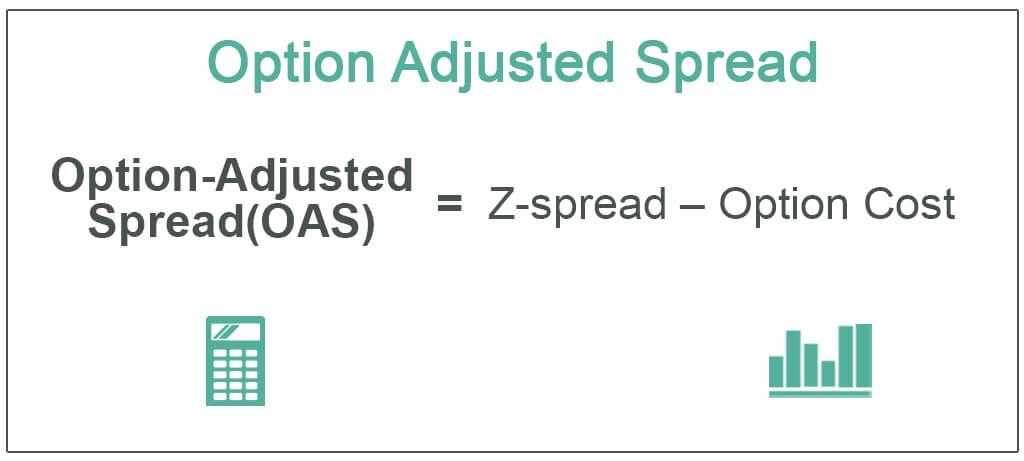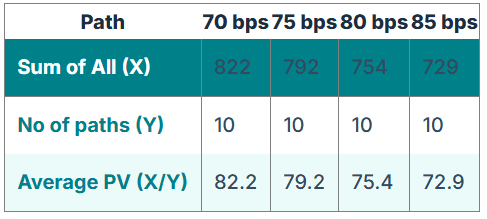Table Of Contents
What is Option Adjusted Spread?
Option-Adjusted Spread (OAS) is a yield spread which is added to the benchmark yield curve to price security with an embedded option. This spread measures the deviation of the security’s performance from the benchmark on the back of an embedded option. It is helpful in determining the price of complicated securities like mortgage-backed securities (MBS), collateralized debt obligations (CDO), convertible debentures, and option-embedded bonds.

Key Takeaways
- The option-adjusted spread (OAS) is a metric used in fixed-income investments to evaluate the additional yield demanded by investors for taking on the risk associated with embedded options in bonds.
- It quantifies the compensation investors require for these options' uncertainty and potential volatility.
- OAS considers the potential impact of embedded options on bond cash flows and adjusts the yield spread accordingly.
- It allows investors to compare and assess the relative attractiveness of bonds with embedded options versus those without options, providing insights into the level of risk associated with variable cash flows.
The formula of Option Adjusted Spread
Spread differs from OAS only to the tune of options cost.
Option-Adjusted Spread(OAS) = Z-spread - Option Cost
Example of Option Adjusted Spreads (OAS)
Using a Monte Carlo simulation model, ten volatility paths are derived, and each path has a weight of 10%. The cash flows on each path are discounted by short-term interest rates plus a spread on that path. The present value of each path is mentioned below:
Present Value if the Spread is
| Path | 70 bps | 75 bps | 80 bps | 85 bps |
|---|---|---|---|---|
| 1 | 92 | 90 | 85 | 83 |
| 2 | 74 | 71 | 67 | 65 |
| 3 | 68 | 64 | 61 | 59 |
| 4 | 77 | 75 | 70 | 68 |
| 5 | 96 | 90 | 86 | 83 |
| 6 | 74 | 71 | 67 | 65 |
| 7 | 86 | 84 | 81 | 79 |
| 8 | 90 | 87 | 84 | 80 |
| 9 | 80 | 78 | 75 | 72 |
| 10 | 85 | 82 | 78 | 75 |
If the market price of the security is $79.2, what is the option-adjusted spread?
If the market price of the security is $75, calculate the option-adjusted spread?
Solution
The theoretical value of the security is the weighted average of the present value of all the paths. Since each path carries the same weight hence taking the simple average would provide the same results.
Present Value if the Spread is
| Path | 70 bps | 75 bps | 80 bps | 85 bps |
|---|---|---|---|---|
| Sum of All (X) | 822 | 792 | 754 | 729 |
| No of paths (Y) | 10 | 10 | 10 | 10 |
| Average PV (X/Y) | 82.2 | 79.2 | 75.4 | 72.9 |
If the market price of the security is $ 79.2, then the corresponding OAS is 75 bps.
If the market price of the security is $ 75, then the option-adjusted spread is computed using linear interpolation.

Difference in bps (between 2 available PVs)
- = 75 - 80
- = -5 bps
The difference in PVs (between 2 available bps)
- = 75.4 - 72.9
- = $ 2.5
Additional OAS (base 80 bps)
- = -5 * (75.4-75) / 2.5
- = -0.8 bps
OAS Spread when the price is $ 75
- = 80 - (-0.8) bps
- = 80.8 bps
Important Points about Option Adjusted Spread
- The price of option-free bonds can be easily measured by discounting the cash flows using the benchmark yield curve. But this is not the case with the securities with embedded options. Volatility in the interest rates plays an important role in ascertaining whether the option is going to be invoked or not.
- The option-adjusted spread is a constant spread which is added to the prevailing interest rates to discount the cash flows. Such discounted cash flows sum to the theoretical value of the security, which in turn indicates the market price of the security.
- OAS uses a number of scenarios carrying possibilities of numerous interest rate paths that are calibrated to the security yield curve. The cash flows are determined along all the paths, and the results are used in arriving at the price of the security.
- In the collateralized mortgage obligation (CMO) market, the OAS on amortization class tranches goes along with the life of the tranches. OAS for shorter maturities is lesser, for medium-term notes are higher with the highest spread on longer-term notes. Hence, OAS turns out to be a bell-shaped curve.
- The difference between option-adjusted and zero-volatility spread provides the implied cost of embedded options in case of asset-backed security.
- When talking about alternatives to OAS, binomial models and other fancier models can be used, but a lot of assumptions are required to be taken to determine the value using such models. Hence, the option-adjusted spread is preferred.
Advantages
- Helps in the computation of the price of a security with an embedded option.
- Reliable as the base calculation is similar to that of z-spread calculation.
- Prepayment probability is based on historical data rather than an estimation.
- Use of advanced models like Monte Carlo analysis in simulation.
Disadvantages
- Complex computation
- Difficult to implement
- Poor interpretation of OAS often results in a deformed view of the behavior of securities
- Prone to model risk
Limitations
Portfolio OAS is taken as the weighted average of the OAS of individual securities where weight is the market price of the securities. This limits the use of OAS to such users who want to inspect the daily contribution to return at present. But to extend its relevance to a wide array of users, the spreads should be weighted by both durations and market weights.
Conclusion
Despite involving complex calculations and placing reliance on sophisticated models, the option-adjusted spread has turned out to be an analytical tool for the evaluation of embedded securities. An improvisation in the areas of limitation can increase its popularity and usage manifold.

